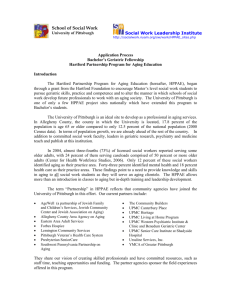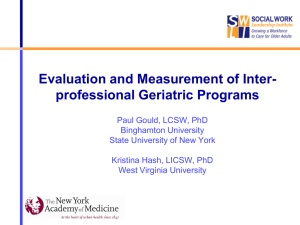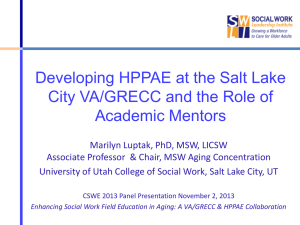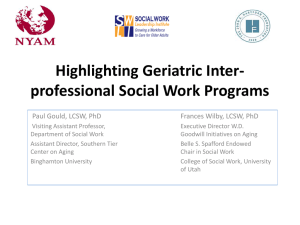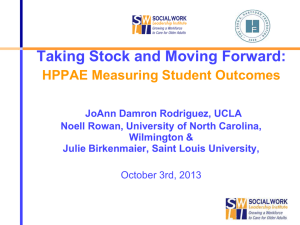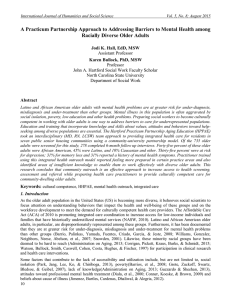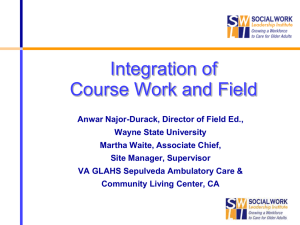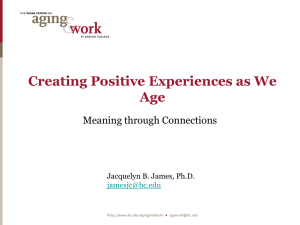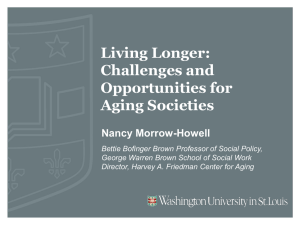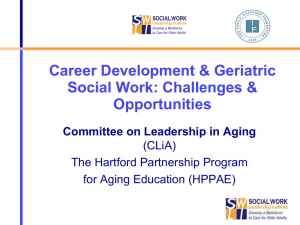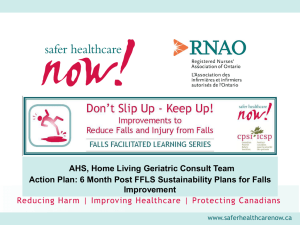PPT
advertisement
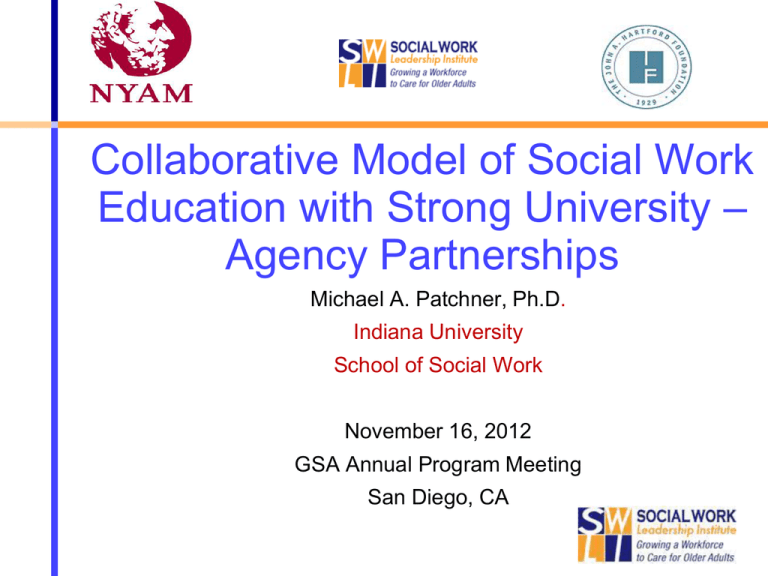
Collaborative Model of Social Work Education with Strong University – Agency Partnerships Michael A. Patchner, Ph.D. Indiana University School of Social Work November 16, 2012 GSA Annual Program Meeting San Diego, CA Master of Social Work Requirements: 2 years of Full-time study or equivalent Components: Coursework Field Education Master of Social Work Core Competencies Identify as a professional social worker and conduct oneself accordingly. Apply social work ethical principles to guide professional practice. Apply critical thinking to inform and communicate professional judgments. Engage diversity and difference in practice. Advance human rights and social and economic justice. Engage in research-informed practice and practice-informed research. Apply knowledge of human behavior and the social environment. Engage in policy practice to advance social and economic well-being and to deliver effective social work services. Respond to contexts that shape practice. Engage, assess, intervene, and evaluate with individuals, families, groups, organizations, and communities. Master of Social Work Coursework Foundation: Human Behavior and the Social Environment Social Work Practice Social Welfare Policy Research Advanced Practice: Specialized Concentration e.g., Geriatric Practice, Mental Health, Health, Advanced Clinical Practice, etc. Field Education Concurrent or Block Relies on agency-university partnerships Is systematically designed, supervised, and coordinated Is evaluated Field Education is Signature Pedagogy in Social Work Education It occurs in settings that reinforce student’s identification with the purposes, values, and ethics of the profession. It fosters the integration of empirical and practice-based knowledge. It promotes the development of professional competences. CSWE Accreditation Standards Require 900 hours of field education for MSW students Specific policies, criteria, and procedures for selecting agencies and field instructors Field liaison contacts with students and field instructors Orientation, training, and continuing dialog with agencies and filed instructors Evaluation of student learning and agency effectiveness in providing field instruction HPPAE Model Exceeds Accreditation Requirements Innovations in Field Education with Expanded Field Instructor Role Focused on strengthening agency-university partnerships Established collaborative relationships of mutual benefit Additional Numbers and Types of Aging Agency Field Placements Aging field agencies at the beginning of the 3 years of the demonstration phase was 0-86 At the end of demonstration period aging agencies numbered 18 to 201. Through HPPAE schools markedly increased the number of aging agencies field sites from 13% to 23% of the total agencies in a three year period For the Adoption phase, the range in number of aging field agencies in year 1 was 4-63, and in year 3 was 5-71 Developed Geriatric Labor Force for Agencies HPPAE Agencies hired HPPAE graduates At the demonstration sites 40% of the graduates were hired by a field placement site At the adoption sites 25% of students were working at one of their HPPAE field practicum sites one year after graduation. Over the 12 years since the program began, many graduates have gone on to become field instructors and supervisors. Enhanced quality of services through university-agency partnerships Local aging networks strengthened - Increased communication, collaboration and resource sharing among agencies HPPAE Resulted in Strong University – Community Partnerships Commitment of agencies sustaining HPPAE programs Enhanced Models of Field Education Enhanced Curriculum Development More Competency-Based Education Student Skills for Interprofessional Practice HPPAE Results of Strong University – Community Partnerships (Cont.) Additional Formal University-Agency Partnerships (5 to 25 more agencies for each school) Relationship Enhancement (Advisory Committees, Meetings between Agencies and Faculty, etc.) Significant Increase in Students in Agency Placements – Increased knowledge of social work in other disciplines Significant Increase in MSW Graduates Prepared for Geriatric Practice (2600 graduates, 72 MSW Programs, 33 states) with More to Come Interprofessional Education & Interdisciplinary Learning Fostered by HPPAE University of Utah Interdisciplinary Seminars offered to Social Work, Medical, Nursing, and Gerontology Students St. Louis University Center for Aging Successfully focused on Interdisciplinary projects, grant and funding opportunities, and educational activities for Social Work, Medical, Public Health, Health Sciences Professions, Public Policy, and Arts and Sciences students Interprofessional Education & Interdisciplinary Learning Fostered by HPPAE College at Brockport, SUNY Geriatric Assessment Consultation Clinic utilizes Academic Geriatricians, Geriatric MD Fellows, Neurophysiologist, Nursing, and Social Work Florida State University HPPAE is a consortium member of the Live Oak Geriatric Education Center. Geriatric Teams with Community Partners include Medicine, Nursing, PT and OT, Exercise Physiology, and Social Work Interprofessional Education & Interdisciplinary Learning Fostered by HPPAE California State University, Chico HPPAE in partnership with Chico Interdisciplinary Center on Aging had 37 community service providers and 19 faculty from different departments at CSU work to institutionalize Gerontology into the MSW program. The Bottom Line • HPPAE Impacted Social Work Education • HPPAE Impacted Geriatric Labor Force www.socialworkleadership.org
